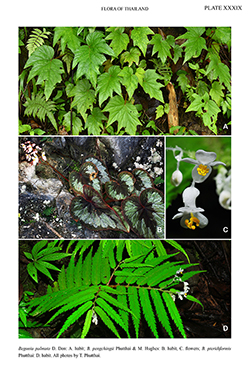e-Flora of Thailand
Volume 14 > Part 3 > Year 2019 > Page 404 > Begoniaceae > Begonia
33. Begonia palmata D.Donwfo-0000825004
[§ Platycentrum], Prodr. Fl. Nepal. 223. 1825; Hara, Fl. E. Himalaya 215. 1966; Hara, Phot. Pl. E. Himalaya 60. 1968; Hara, Fl. E. Himalaya 2: 84. 1971; Hughes, Annot. Checkl. SE Asian Begonia. 94. 2008; Camfield & Hughes, Eur. J. Taxon. 396: 70. 2018. Plate XXXIX: A.
Accepted Name : This is currently accepted.
Synonyms & Citations :
Description : Monoecious caulescent herb, 30–90 cm tall. Stems erect, terete, dark red with densely villous hairs, rhizome elongate with numerous fibrous roots, sparsely villous hairy, ca 20 mm diam. Leaves 3–7 per plant; petiole 5−20 (–30) cm long, densely brown villous hairy; lamina basifixed, membranaceous, asymmetric, chartaceous when dry, adaxial surface densely minute echinate hairy, dull dark green or light bright green, abaxial surface sparsely brown villous hairy on veins, pale green or pale pink on veins, palmatifid, 12−30 by 7−28 cm, base obliquely cordate, apex acuminate to elongate-acuminate, margin sinuate or denticulate with 3−7, shallowly or deeply divided lobed, venation palmate, midrib and lateral veins concolourous with lamina, 5−10 veins, slightly impressed above, prominent beneath. Stipules caducous, dark red, ovate, 2−3 by 1.8 mm, apex cuspidate, margin ciliate. Inflorescences terminal, bisexual, 10−20 cm long, dichasial or polychasial, branching 1–2 times with 3–12 staminate flowers and 2–8 pistillate flowers per branch, protandrous; peduncle 15−25 cm long, terete, pale green with densely brown villous hairs. Bracts caducous, dark red, ovate, 1−15 by 4−10 mm, brown villous hairs, apex acute, margin ciliate. Staminate flowers: pedicels pale green, 10−20 mm long, brown villous hairs; tepals 4, white or pale pink, outer 2 ovate to orbicular, 10−30 by 9−25 mm, base rounded, apex rounded, margin slightly crenate, outer parts tomentose, inner parts glabrous, inner 2 obovate, 7−24 by 5−10 mm, base obtuse, apex obtuse, margin entire, glabrous on both sides; androecium actinomorphic, globose, stamens numerous, yellow, filaments nearly free, 10−22 mm long, anthers oblong or obovate, 2−2.5 mm long, dehiscing by longitudinal slits. Pistillate flowers: pedicels pale green, 10−20 mm long, dense brown villous hairs; tepals 5(−6), white or pale pink, unequal, 4 ovate to orbicular, pubescent outside, 7−23 by 4−29 mm, 1 obovate, 8−20 by 4−8 mm, pubescent outside; styles 2, fused at base, twice spirally twisted, stigmatic band crescent-shaped and spiral; ovary dark red or pale pink or pale green with brown villous hairs; ovary with 3 unequal wings, 2-locular, placentae bilamellate. Fruit a dehiscent capsule, dark red or pale green with brown villous hairs, drying pale brown, 20−30 by 10−15 mm; locules obovate, 14 by 8 mm, abaxial wing oblong or oblique triangular, 10−35 mm long, 2 laterals narrower, rectangular, curved along length of capsule, 4−5 mm long. Seeds brown, barrel-shaped.
Thailand : NORTHERN: Chiang Mai, Mae Hong Son, Nan, Lampang, Phittsanulok, Kamphaeng Phet, Sukhothai; NORTH-EASTERN: Loei; EASTERN: Nakhon Ratchasima.
Distribution : India, Nepal (type), China, Myanmar, Laos, Vietnam.
Ecology : On wet soil or in sandstone rock crevices in evergreen hill forests, 700−2,000 m alt. Flowering: May–November; fruiting: November–January.
Vernacular : Som kung (ส้มกุ้ง).
Notes: Begonia palmata is common at high altitudes. The silky brown villous indumentum of this species is unique in Begonia in Thailand, and is a useful diagnostic character to distinguish it from other species with palmate leaves.

